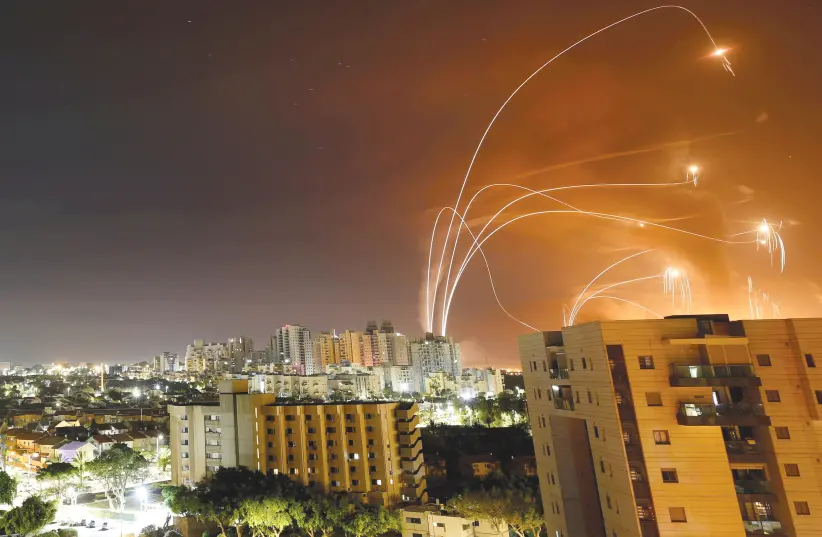AIRON DOME interceptors destroy rockets launched from the Gaza Strip toward Israel in the skies over Ashkelon in May.
(photo credit: AMIR COHEN/REUTERS)
The report was compiled by the Gaza Assessment Task Force of the Jewish Institute for National Security of America.
The recent conflict “reveals the need for cooperation between the United States, Israel, and like-minded nations to address the threat posed by the proliferation of both advanced and effective low-end capabilities from state sponsors of terrorism like Iran and North Korea to unconventional adversaries like Hamas,” the report says.
The report was compiled by JINSA’s Gemunder Center Gaza Assessment Policy Project. The independent policy project was comprised of senior and retired US military officers who were able to travel to Israel to examine the actions of both sides in the recent conflict. Among those involved with the project were former Defense Intelligence Agency director Lt.-Gen. Robert Ashley, former senior defense official in Iraq Lt.-Gen. John M. Bednarek, former US Army Europe chief of international law Lt.-Col. Geoffrey S. Corn, former deputy commandant for aviation Lt.-Gen. Jon Davis, former deputy director for national intelligence for national security partnerships Lt.-Gen. Karen Gibson, and former commanding general of I Corps and Joint Base Lewis-McChord Lt.-Gen. Stephen Lanza.
The report notes that Hamas and Palestinian Islamic Jihad changed their plans significantly after absorbing the lessons of 2014 was and advancing their research and development efforts. “In the previous conflict, they aimed to overwhelm command and control for Iron Dome by launching relatively small volleys of rockets toward multiple fronts in Israel simultaneously. With Iranian encouragement, in 2021 rockets were fired from Gaza in much larger salvos – as many as 150 projectiles at a time – at one single target area in Israel, usually a large city, in deliberate attempts to overpower a single Iron Dome battery. Yet this generally was no more successful than the 2014 tactics, thanks to parallel advancements in Israel’s air defenses.”
The report notes that the US also confronts similar threats from Iranian-backed militias around the Middle East. For instance, Iran has used drones to attack the Tanf base in Syria recently. Iran has increased its use of drones against the US in Iraq and also used drones to attack a ship in the Gulf of Oman in July. The authors argue that processes we see in conflicts here now have parallels in other places where Russia and China also use proxies and conduct cyberattacks.
“This strategic backdrop helps explain the IDF’s emphasis on a short, decisive Gaza campaign that would not bog Israel down and pull focus from its primary challenge. In quickly eliminating as many Hamas and PIJ military assets as it could, it sought in part to deter these groups from reigniting hostilities for the longest possible period of time—thereby maximizing Israel’s freedom of maneuver to address higher-level threats from Iran,” the report notes. “Furthermore, during the May 2021 conflict, when Iran sought to further divert the IDF’s attention through proxy rocket and drone attacks from Lebanon and Syria, Israel conspicuously chose to minimize the risks of escalation by retaliating in limited fashion or not at all. Finally, even while trying to end the conflict quickly, the IDF had to hold back operational capabilities and weapons stocks for the possibility of concurrent or future, larger-scale conflicts with Iran and Hezbollah in the North.”
Iran supplies Hamas with technology such as rockets and drones. The report notes the importance of these new capabilities, including “electronic warfare” that was apparently used by Hamas in Gaza. “The growth of advanced capabilities among hybrid adversaries – including EW, UAVs, tunnels, and the capability to employ high-volume rocket salvos and potentially drone swarms – reveals the need for cooperation between the United States, Israel, and like-minded nations to monitor and interdict transfers of weapons and dual-use technology. It also requires joint research and development efforts to develop solutions for threats such as large-scale mortar salvos and remotely piloted vehicle (RPV) swarms, including exploring the need for directed-energy weapons (DEW) and Counter Rocket, Artillery, and Mortar (C-RAM) systems,” the authors conclude
“The low-flying maneuverable UAVs offered an element of precision unavailable in its unguided rocket arsenals; accordingly, during the conflict Hamas launched them at high-value targets like critical infrastructure in Israel, including an offshore natural gas platform near Gaza. Thanks again to improvements to Iron Dome as well as the use of combat aircraft, these UAV strikes also proved unsuccessful.” This is important because Israel has increased the capabilities of Iron Dome in recent years. The US has also acquired two Iron Dome batteries.
The need for more cooperation between Israel, the US and other partners is clear from the recent conflict. This report helps provide more evidence for the need to look at the kinds of conflicts Israel faces as foreshadowing other conflicts that the US may face globally.

